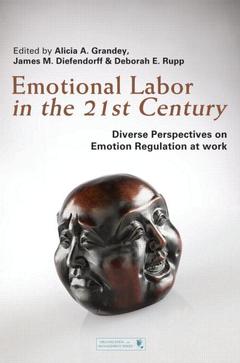Emotional Labor in the 21st Century Diverse Perspectives on Emotion Regulation at Work Organization and Management Series

This book reviews, integrates, and synthesizes research on emotional labor and emotion regulation conducted over the past 30 years. The concept of emotional labor was first proposed by Dr. Arlie Russell Hochschild (1983), who defined it as "the management of feeling to create a publicly observable facial and bodily display" (p. 7) for a wage. A basic assumption of emotional labor theory is that many jobs (e.g., customer service, healthcare, team-based work, management) have interpersonal, and thus emotional, requirements and that well-being and effectiveness in these jobs is determined, in part, by a person?s ability to meet these requirements. Since Hochschild?s initial work, psychologists, sociologists, and management scholars have developed distinct theoretical approaches aimed at expanding and elaborating upon Hochschild?s core ideas. Broadly speaking, emotional labor is the study of how emotion regulation of oneself and others influences social dynamics at work, which has implications for performance and well being in a wide range of occupations and organizational contexts.
This book offers researchers and practitioners a review of emotional labor theory and research that integrates the various perspectives into a coherent framework, and proposes an agenda for future research on this increasingly relevant and important topic. The book is divided into 5 main sections, with the first section introducing and defining emotional labor as well as creating a framework for the rest of the book to follow. The second section consists of chapters describing emotional labor theory at different levels of analysis, including the event, person, dyad, and group. The third section illustrates the diversity of emotional labor in distinct occupational contexts: customer service (e.g. restaurant, retail), call centers, and caring work. The fourth section considers broader contextual influences ? organizational-, societal-, and cultural-level factors ? that modify how and when emotional labor is done. The final section presents a series of ?reflective essays? from eminent scholars in the area of emotion and emotion regulation, where they reflect upon the past, present and future of emotion regulation at work.
Part 1: Overview 1. Bringing Emotional Labor into Focus: A Review and Integration of Three Research Lenses Alicia A. Grandey, James M. Diefendorff, Deborah E. Rupp Part 2: Person Perspectives: Within, Between, Dyadic And Group 2. Episodic Intrapersonal Emotion Regulation: Or, Dealing with Life as it Happens Daniel J. Beal, John P. Trougakos 3.Motivation, Fit, Confidence, and Skills: How Do Individual Differences Influence Emotional Labor? Jason J. Dahling, Hazel-Anne Johnson 4. The Social Effects of Emotion Regulation in Organizations Stéphane Côté, Gerben A. Van Kleef, Thomas Sy 5. Emotional Labor at the Unit-level Karen Niven, Peter Totterdell, David Holman, David Cameron Part 3: Occupational Perspectives: Customer Service, Call Centers, Caring Professionals 6. The Customer Experience of Emotional Labor Markus Groth, Thorsten Hennig-Thurau, Karyn Wang 7. Call Centers: Emotional Labor Over the Phone Danielle van Jaarsveld, Winnie R. Poster 8. Attending to Mind and Body: Engaging the Complexity of Emotion Practice Among Caring Professionals Rebecca J. Erickson, Clare L. Stacey Part 4: Contextual Perspectives: Organization, Gender, Culture 9. Emotional Labor: Organization-level Influences, Strategies, and Outcomes S. Douglas Pugh, James M. Diefendorff, Christina M. Moran 10.Social and Cultural Influencers: Gender Effects on Emotional Labor at Work and at Home Kathryn J. Lively 11. A Cultural Perspective on Emotion Labor Batja Mesquita, Ellen Delvaux Part 5: Multi-Disciplinary Perspectives: Reflections and Projections 12. Emotional Labor: Looking Back Nearly 20 Years Blake E. Ashforth, Ronald H. Humphrey 13. Emotional Labor Across Five Levels of Analysis: Past, Present, Future Neal Ashkanasy, Catherine Daus 14. Conceptualizing Emotional Labor: An Emotion Regulation Perspective James Gross 15. Reflecting on Emotional Labor as a Social Meme Anat Rafaeli 16. Back to the Future Amy S. Wharton
Date de parution : 09-2012
15.2x22.9 cm
Date de parution : 05-2017
15.2x22.9 cm
Thèmes d’Emotional Labor in the 21st Century :
Mots-clés :
deep; acting; display; rules; regulation; process; exhaustion; surface; literature; research; Customer Mistreatment; National Identity Management; Call Center Settings; EL; Emotional Exhaustion; Positive Service Climate; Service Quality Judgments; Display Rule Requirements; Deep Acting; Display Rules; Van Kleef; El Process; Affect Control Theory; Emotional Labor Strategies; Interpersonal Emotion Regulation; Emotional Labor Research; Emotional Labor Literature; Call Center Workforce; Emotional Dissonance; Emotion Regulation; Call Center Employees; Employee Emotional Labor; Emotion Practice; Call Center Context; Call Center Work



